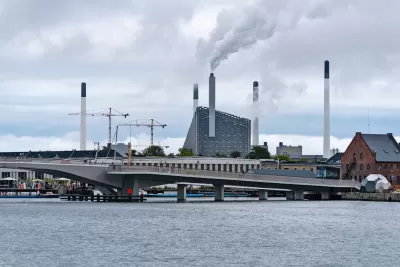Bettina Kamuk, global market director for Ramboll, explains how a Copenhagen waste-to-energy facility meets air quality and emissions standards while providing low-carbon energy and recreational activity to the surrounding community.

With China no longer accepting imports of post-consumer recyclables from the United States, California’s waste facilities are struggling to manage the sudden increase in volume and demand on its waste disposal facilities. Waste-to-energy conversion plants—a staple of European circular economic models to address waste management and reach decarbonization goals— face, despite success in Europe, significant public relations and political challenges in U.S. cities.
To better understand the latest innovative science behind waste-fired power plants globally, TPR recently toured Amager Bakke, a waste-to-energy plant (and, yes, ski slope attraction) in Copenhagen, Denmark; and, spoke with Bettina Kamuk, Global Market Director for Ramboll, who explained how the Copenhagen facility meets air quality and emissions standards while providing low-carbon energy and recreational activity to its surrounding community.
"The Amager Bakke waste-to-energy (WtE) facility, which we engineered and designed, supplies one-third of all heat to Copenhagen, and is part of Denmark’s 2010 national strategy to reduce all dependency on fossil fuels by 2030. The Amager Bakke WtE facility is owned and operated by Amager Resource Centre (ARC), a five city consortia, to supply low-carbon electricity to 550,000 people and district heating to 140,000 households.
This plant replaced a 45-year-old facility. ARC’s objectives were to replace the aging lines of this facility, produce a lower emission, more efficient plant that would have a higher recovery of materials like metals, and be a beacon for the city, open to the public. Everyone knows that we are building a ski slope on the roof and that this facility is in the center of the city. We don’t hide what we’re doing. We show what we’re doing with our waste."
Read the full interview on The Planning Report.
FULL STORY: Denmark's Amager Bakke Waste-to-Energy Plant: a Global Model of Sustainable Design & Efficiency

Maui's Vacation Rental Debate Turns Ugly
Verbal attacks, misinformation campaigns and fistfights plague a high-stakes debate to convert thousands of vacation rentals into long-term housing.

Planetizen Federal Action Tracker
A weekly monitor of how Trump’s orders and actions are impacting planners and planning in America.

San Francisco Suspends Traffic Calming Amidst Record Deaths
Citing “a challenging fiscal landscape,” the city will cease the program on the heels of 42 traffic deaths, including 24 pedestrians.

Defunct Pittsburgh Power Plant to Become Residential Tower
A decommissioned steam heat plant will be redeveloped into almost 100 affordable housing units.

Trump Prompts Restructuring of Transportation Research Board in “Unprecedented Overreach”
The TRB has eliminated more than half of its committees including those focused on climate, equity, and cities.

Amtrak Rolls Out New Orleans to Alabama “Mardi Gras” Train
The new service will operate morning and evening departures between Mobile and New Orleans.
Urban Design for Planners 1: Software Tools
This six-course series explores essential urban design concepts using open source software and equips planners with the tools they need to participate fully in the urban design process.
Planning for Universal Design
Learn the tools for implementing Universal Design in planning regulations.
Heyer Gruel & Associates PA
JM Goldson LLC
Custer County Colorado
City of Camden Redevelopment Agency
City of Astoria
Transportation Research & Education Center (TREC) at Portland State University
Jefferson Parish Government
Camden Redevelopment Agency
City of Claremont


























